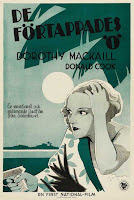Without giving away the ending, this is not the happiest movie on the planet. Gilda's life IS hell, and life on this little island doesn't make it any better. For the most part, the members of my review panel did not enjoy the film, though I myself do like it. It's a tough movie, but the performance of Dorothy Mackaill makes it a standout for me. Gilda doesn't always make the best choices, but her strength and determination make her a character worth watching.
The part of the script that my group found most difficult to accept was Carl's decision to bring her to this abysmal environment. First, she has to endure three days in a box in the hold of a ship, then she ends up on an island full of very nasty men. Yes, the island has no extradition treaty with the U.S., but since Carl plans on bringing her home once the furor dies down, one would think he could find a safer place to stash her. This is, after all, not the age of the Internet - drop her in a big city somewhere, give her money to live, change her name and appearance a bit, and she can get lost for a good long time. Is Carl (as suggested by my colleague at Pre-code.com) punishing her for her actions or protecting her? Given the outcome of the film, it's hard to determine what his motivation could be.
Perhaps what makes this film a film worth watching (besides Ms. Mackaill's exemplary performance) are the portrayals of Leonie (Nina Mae McKinney) and Newcastle (Clarence Muse), the only really good people in the film. This is notable because both Mr. Muse and Ms. McKinney are black. But, we are not treated to servile idiots. Both Leonie and Newcastle are intelligent and well-spoken. (This TCM article comments that the original script had the character doing the usual southern black dialect, but it seems director William Wellman changed it). Leonie and Newcastle work in this horrid environment, but they have not absorbed it. Their affection for Gilda is evident, as is hers for them. Ms. McKinney, who has a lovely singing voice, gets to do one song, the clip below features just that part of her sensitive performance:
It's a shame that Dorothy Mackaill had such a brief career. She started in silent films (she had two Broadway appearances around the same time - appearing in one of Florenz Ziegfeld shows in 1921). She was a WAMPAS Baby Star in 1924, and apparently made the transition to sound smoothly - in 1931, she appeared in 6 films. But by 1934, her star was starting to wain. She made two pictures that year, and then nothing until 1937 (last week's Bulldog Drummond at Bay). With that, she retired to care for her mother. In 1947, she married Harold Patterson, an orchid grower in Hawaii (they divorced the following year). She made Hawaii her home, living at the Royal Hawaiian Hotel (sometimes called "The Pink Palace") for the rest of her life. In the 1970s, she appeared in two episodes of Hawaii Five-O - it was after all, filmed in her home town! When she died, her ashes were scattered off her beloved Waikiki Beach. She was 87 (Here is her obituary from the LA Times).
According to this articles from AFI, a number of different people were considered for this film, including Barbara Stanwyck and Lillian Bond as Gilda, David Manners as Carl, and Boris Karloff, with Michael Curtiz originally slated to direct. This would have been the time period in which Ten Cents a Dance and Night Nurse were released, so perhaps it was better for Stanwyck not to have been given the role of yet another woman with an "image problem."
We'll close with Dorothy's arrival in hell. I'd also like to recommend reviews from two of my fellow bloggers at Immortal Ephemera and Pre-code.com. Both have spoilers, but are excellent analyses of this difficult film. Next time, we'll discuss a comedy with another of our favorite actresses, Olivia de Havilland.



No comments:
Post a Comment
Thanks for your interest in this blog. Your comments will be moderated to minimize spam to the website. Thanks for understanding.